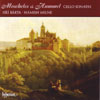Hummel; Moscheles Cello Sonatas
An amiable outing from a virtuoso pair, even if the cellist is given a back seat
View record and artist detailsRecord and Artist Details
Composer or Director: Ignaz Moscheles, Johann Nepomuk Hummel
Genre:
Chamber
Label: Hyperion
Magazine Review Date: 7/2006
Media Format: CD or Download
Media Runtime: 65
Mastering:
Stereo
DDD
Catalogue Number: CDA67521

Tracks:
| Composition | Artist Credit |
|---|---|
| Sonata for Cello and Piano |
Johann Nepomuk Hummel, Composer
Hamish Milne, Piano Jirí Bárta, Cello Johann Nepomuk Hummel, Composer |
| Sonata for Cello and Piano No 2 |
Ignaz Moscheles, Composer
Hamish Milne, Piano Ignaz Moscheles, Composer Jirí Bárta, Cello |
| Melodic-contrapuntal Studies, Movement: No 4. Prelude in E flat |
Ignaz Moscheles, Composer
Hamish Milne, Piano Ignaz Moscheles, Composer Jirí Bárta, Cello |
| Melodic-contrapuntal Studies, Movement: No 8. Prelude in D minor |
Ignaz Moscheles, Composer
Hamish Milne, Piano Ignaz Moscheles, Composer Jirí Bárta, Cello |
| Melodic-contrapuntal Studies, Movement: No 9. Prelude in C sharp minor |
Ignaz Moscheles, Composer
Hamish Milne, Piano Ignaz Moscheles, Composer Jirí Bárta, Cello |
Author: Edward Greenfield
Hummel and Moscheles make an apt pair: each was a keyboard virtuoso who wrote prolifically. Yet where Hummel has been well represented on disc lately, Moscheles is far more neglected. That makes the new issue specially valuable. Their careers overlapped, but Moscheles lived for 33 years more after Hummel died, actively composing till the last. The works here appeared some three decades apart – not that the stylistic contrast is at all marked, for both adopted an easily lyrical style celebrating the early 19th rather than the 18th century, with Mendelssohn more of an influence than Mozart.
This is particularly so in Moscheles’s Cello Sonata of 1850-51, with one or two echoes of the Mendelssohn Octet and with a Scherzo marked ballabile, sparkling in the way one expects of Mendelssohn. The younger composer, a close friend, also influenced Moscheles in his devotion to Bach, represented here by the three Melodic-Contrapuntal Studies, involving flowing melodic writing for the cello neatly fitted to Bach’s original keyboard Preludes.
Following tradition, Moscheles gives priority to the piano over the cello in describing the work, not surprising from a pianist-composer, and this recording rather brings that out; the sensitive cellist, Jirí Bárta, is regularly overshadowed. What is more unexpected is how the last two movements echo Czech music, not just in the rhythms and melodic shapes of some of the themes but in the alternation of speeds; that suggests that Moscheles was influenced by the Czech dumka. The Sonata is rounded off with a dashing movement in which Moscheles encourages the pianist to show off in several passages.
Otherwise this is a work designed for intimate music-making, and that is even more clearly so in the Hummel Sonata, which opens with a triple-time Allegro amabile. ‘Amiable’ is an apt description of the piece, not just in that lyrical first movement but the central Romanze which is rather like early Beethoven. Here, too, there are echoes of the music of eastern Europe in the finale, maybe influenced by Hummel’s tours of Russia and Poland.
Though it is a pity that Bárta is not presented as a full equal to Milne (who plays brilliantly), the recording balance is largely to blame. An attractive disc nonetheless.
This is particularly so in Moscheles’s Cello Sonata of 1850-51, with one or two echoes of the Mendelssohn Octet and with a Scherzo marked ballabile, sparkling in the way one expects of Mendelssohn. The younger composer, a close friend, also influenced Moscheles in his devotion to Bach, represented here by the three Melodic-Contrapuntal Studies, involving flowing melodic writing for the cello neatly fitted to Bach’s original keyboard Preludes.
Following tradition, Moscheles gives priority to the piano over the cello in describing the work, not surprising from a pianist-composer, and this recording rather brings that out; the sensitive cellist, Jirí Bárta, is regularly overshadowed. What is more unexpected is how the last two movements echo Czech music, not just in the rhythms and melodic shapes of some of the themes but in the alternation of speeds; that suggests that Moscheles was influenced by the Czech dumka. The Sonata is rounded off with a dashing movement in which Moscheles encourages the pianist to show off in several passages.
Otherwise this is a work designed for intimate music-making, and that is even more clearly so in the Hummel Sonata, which opens with a triple-time Allegro amabile. ‘Amiable’ is an apt description of the piece, not just in that lyrical first movement but the central Romanze which is rather like early Beethoven. Here, too, there are echoes of the music of eastern Europe in the finale, maybe influenced by Hummel’s tours of Russia and Poland.
Though it is a pity that Bárta is not presented as a full equal to Milne (who plays brilliantly), the recording balance is largely to blame. An attractive disc nonetheless.
Discover the world's largest classical music catalogue with Presto Music.

Gramophone Digital Club
- Digital Edition
- Digital Archive
- Reviews Database
- Full website access
From £8.75 / month
Subscribe
Gramophone Full Club
- Print Edition
- Digital Edition
- Digital Archive
- Reviews Database
- Full website access
From £11.00 / month
Subscribe
If you are a library, university or other organisation that would be interested in an institutional subscription to Gramophone please click here for further information.




